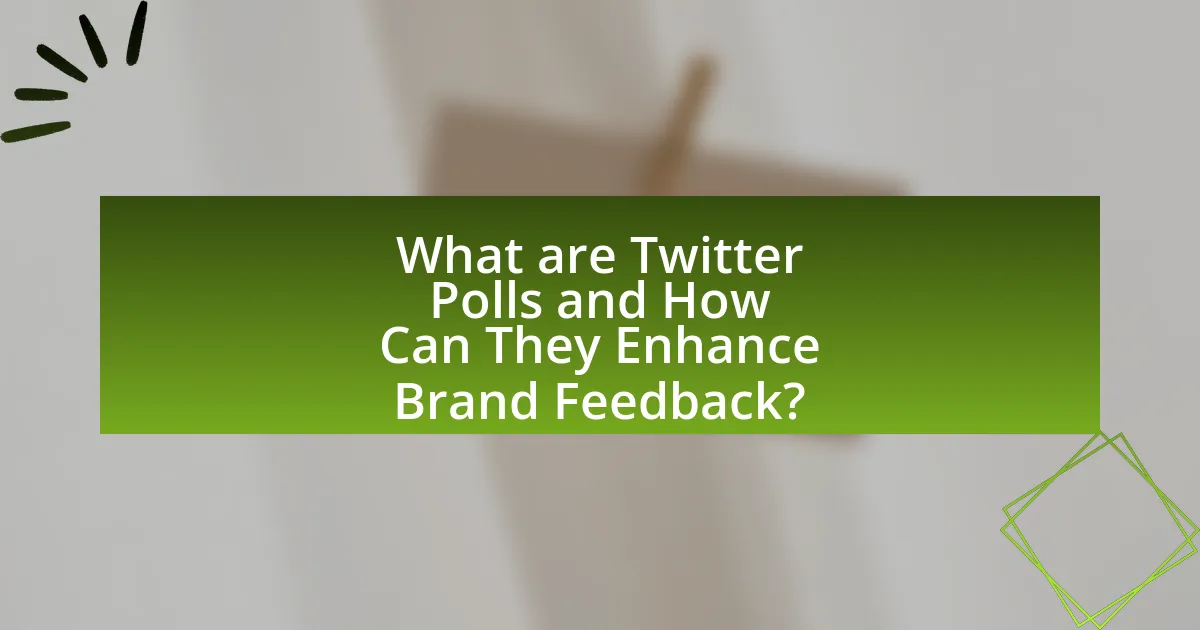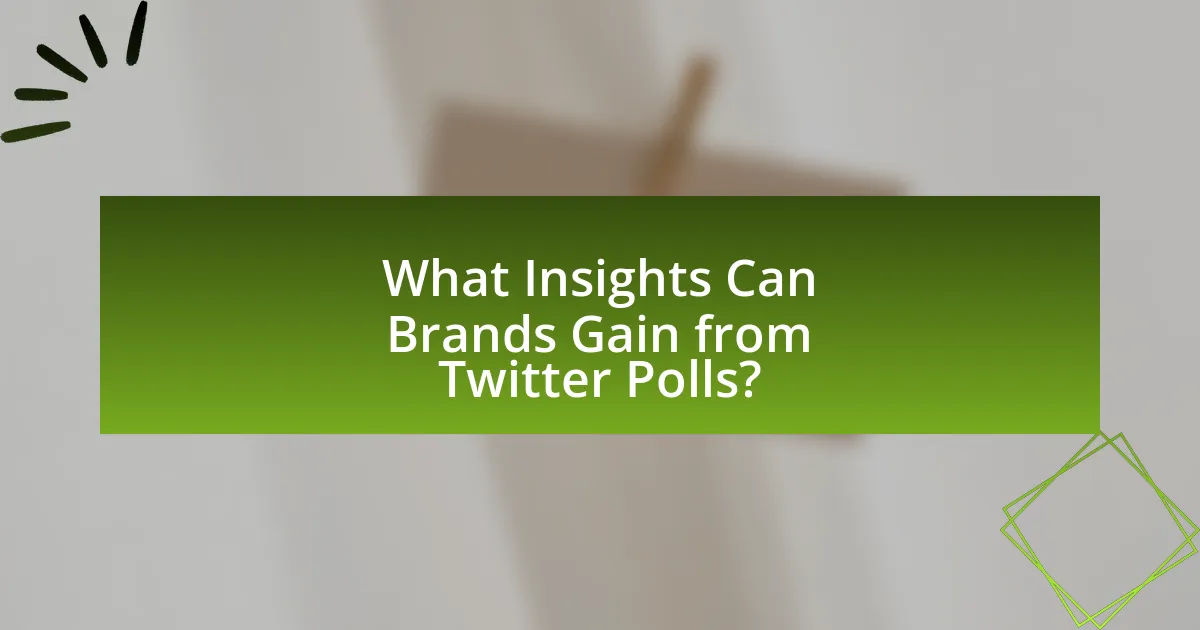Twitter Polls are interactive features on the platform that enable users to create and participate in polls with multiple-choice questions, providing brands with immediate insights into customer preferences and opinions. This article outlines how Twitter Polls function, their key features, and the advantages they offer for brand engagement and feedback. It also discusses best practices for creating effective polls, strategies for maximizing visibility and engagement, and how brands can analyze poll results to gain actionable insights. By leveraging Twitter Polls, brands can enhance customer interaction, tailor their offerings, and foster loyalty among their audience.

What are Twitter Polls and How Can They Enhance Brand Feedback?
Twitter Polls are interactive features on the platform that allow users to create and participate in polls with multiple-choice questions. These polls enhance brand feedback by providing businesses with immediate insights into customer preferences and opinions, enabling them to make data-driven decisions. According to a study by Sprout Social, 70% of consumers feel more connected to brands that engage with them on social media, and Twitter Polls facilitate this engagement by encouraging direct interaction. By analyzing poll results, brands can identify trends, gauge customer satisfaction, and tailor their products or services to better meet audience needs.
How do Twitter Polls function within the platform?
Twitter Polls allow users to create interactive surveys directly within tweets, enabling followers to vote on specific questions. Users can set up a poll by selecting the poll option when composing a tweet, entering a question, and providing up to four answer choices. Each poll remains active for a predetermined duration, ranging from five minutes to seven days, during which followers can cast their votes. The results are displayed in real-time, allowing users to see how many votes each option has received. This functionality encourages engagement and feedback, making it a valuable tool for brands seeking insights from their audience.
What are the key features of Twitter Polls?
Twitter Polls allow users to create interactive surveys with up to four answer options, enabling quick feedback from followers. Each poll can last from 5 minutes to 7 days, providing flexibility in engagement duration. Users can view real-time results, which fosters transparency and encourages participation. Additionally, Twitter Polls are easily shareable, increasing their reach and potential impact on brand feedback. These features collectively enhance user interaction and provide valuable insights for brands.
How do users interact with Twitter Polls?
Users interact with Twitter Polls by selecting one of the provided options to express their opinions or preferences. This interaction occurs when users click on their chosen response, which then registers their vote and updates the poll results in real-time. According to Twitter’s own data, polls can increase engagement, as they allow users to participate in discussions and share their views easily, leading to higher interaction rates compared to standard tweets.
Why should brands utilize Twitter Polls for feedback?
Brands should utilize Twitter Polls for feedback because they provide a quick and interactive way to gauge audience opinions. Twitter Polls allow brands to engage directly with their followers, facilitating real-time responses that can inform decision-making. According to a study by Sprout Social, 70% of consumers feel more connected to brands that actively seek their opinions, highlighting the effectiveness of polls in fostering engagement and loyalty. Additionally, Twitter’s user base is highly active, with over 330 million monthly active users, making it an ideal platform for gathering diverse feedback efficiently.
What advantages do Twitter Polls provide for brand engagement?
Twitter Polls enhance brand engagement by facilitating direct interaction with audiences, allowing brands to gather real-time feedback and insights. This interactive feature encourages participation, as users can express their opinions quickly and easily, leading to increased engagement rates. According to a study by Twitter, tweets that include polls receive 2.5 times more engagement than those without, demonstrating their effectiveness in capturing audience attention and fostering a sense of community. Additionally, polls can inform brands about customer preferences and trends, enabling them to tailor their strategies accordingly, which ultimately strengthens brand loyalty and connection.
How can Twitter Polls help in understanding customer preferences?
Twitter Polls can effectively gauge customer preferences by providing a direct and interactive platform for feedback. These polls allow brands to ask specific questions and receive immediate responses from their audience, facilitating real-time insights into consumer opinions and desires. For instance, a study by Sprout Social found that 70% of users appreciate brands that engage with them through polls, indicating a strong correlation between engagement and customer satisfaction. This data underscores the value of Twitter Polls in not only collecting preferences but also enhancing brand loyalty through active participation.

How to Create Effective Twitter Polls for Brand Feedback?
To create effective Twitter polls for brand feedback, focus on clear, concise questions that directly relate to your brand’s objectives. Ensure that the options provided are distinct and cover a range of possible responses to capture diverse opinions. For instance, a poll asking, “Which product feature do you value most?” can include options like “Quality,” “Price,” “Design,” and “Functionality.” This approach allows for targeted insights into customer preferences.
Additionally, timing and audience engagement are crucial; posting polls during peak activity hours increases visibility and participation. According to a study by Twitter, tweets with polls receive 150% more engagement than standard tweets, highlighting the effectiveness of this format in gathering feedback. By leveraging these strategies, brands can obtain actionable insights that inform product development and marketing strategies.
What steps are involved in setting up a Twitter Poll?
To set up a Twitter Poll, first, compose a new tweet and select the poll icon. Next, enter your question in the tweet box and provide up to four answer options. After that, set the duration for how long you want the poll to run, which can range from five minutes to seven days. Finally, click “Tweet” to publish the poll. This process allows users to engage with your brand by providing feedback on specific questions or topics.
How do you formulate questions for Twitter Polls?
To formulate questions for Twitter Polls, focus on clarity and brevity to ensure engagement. Effective questions should be straightforward, allowing respondents to easily understand and choose from the provided options. For instance, instead of asking, “What do you think about our new product?” a more effective question would be, “How do you feel about our new product: Love it, Like it, Neutral, Dislike it?” This structure encourages participation by presenting clear choices. Research indicates that polls with concise and direct questions yield higher engagement rates, as users are more likely to respond when the question is easily digestible.
What are the best practices for choosing poll options?
The best practices for choosing poll options include ensuring clarity, relevance, and balance among the options. Clarity is essential; each option should be easily understood to avoid confusion. Relevance ensures that the options align with the audience’s interests and the poll’s purpose, enhancing engagement. Balance among options prevents bias, allowing for a fair representation of opinions. For instance, a study by Pew Research Center indicates that well-structured polls yield more accurate insights, demonstrating the importance of these practices in gathering meaningful feedback.
How can brands promote their Twitter Polls for maximum engagement?
Brands can promote their Twitter Polls for maximum engagement by leveraging their existing audience and utilizing strategic timing. Engaging with followers through direct mentions, retweets, and incorporating polls into broader conversations can significantly increase visibility. Additionally, brands should consider posting polls during peak engagement times, which research indicates can be between 12 PM and 3 PM on weekdays, to capture more responses. Using eye-catching visuals and clear, concise language in the poll questions can also enhance participation rates. Furthermore, promoting polls across other social media platforms and encouraging followers to share can amplify reach and engagement.
What strategies can be used to increase visibility of Twitter Polls?
To increase the visibility of Twitter Polls, brands should leverage strategic timing, engaging visuals, and targeted promotion. Posting polls during peak engagement hours, such as early evenings or weekends, maximizes exposure, as studies show that tweets receive higher interaction rates during these times. Incorporating eye-catching images or GIFs alongside the poll can attract more attention, as tweets with visuals are known to receive 150% more retweets than those without. Additionally, promoting polls through retweets, mentions, and hashtags relevant to the target audience can significantly enhance reach, as using popular hashtags can increase visibility by up to 50%.
How can timing affect the response rate of Twitter Polls?
Timing significantly affects the response rate of Twitter polls by influencing when users are most active and engaged. Research indicates that posting polls during peak usage times, such as weekday afternoons or evenings, can lead to higher engagement rates, as more users are likely to see and participate in the poll. For instance, a study by Sprout Social found that tweets posted on Wednesdays and Fridays receive the highest engagement, suggesting that timing can directly correlate with the number of responses received. Therefore, strategically scheduling polls to align with user activity patterns can enhance participation and yield more valuable feedback for brands.

What Insights Can Brands Gain from Twitter Polls?
Brands can gain valuable insights from Twitter polls by understanding customer preferences, gauging brand perception, and identifying market trends. Twitter polls provide direct feedback from followers, allowing brands to assess what products or services resonate most with their audience. For instance, a poll asking followers to choose between two product designs can reveal which option is more appealing, guiding design decisions. Additionally, analyzing poll responses can help brands measure customer sentiment and engagement levels, as seen in a study by Sprout Social, which found that 70% of consumers feel more connected to brands that actively seek their opinions. This data-driven approach enables brands to tailor their strategies effectively, enhancing customer loyalty and driving sales.
How can brands analyze the results of Twitter Polls?
Brands can analyze the results of Twitter Polls by reviewing the percentage of votes each option received and assessing the overall engagement metrics. This analysis allows brands to gauge audience preferences and sentiments effectively. For instance, if a poll receives a high number of votes, it indicates strong interest in the topic, while the distribution of votes among options reveals specific preferences. Additionally, brands can track comments and retweets related to the poll to gain qualitative insights, enhancing their understanding of audience reactions. This method of combining quantitative data from votes with qualitative feedback provides a comprehensive view of consumer opinions and can inform future marketing strategies.
What metrics should brands focus on when evaluating poll results?
Brands should focus on response rate, demographic breakdown, sentiment analysis, and engagement metrics when evaluating poll results. The response rate indicates how many users participated, providing insight into the poll’s reach and relevance. Demographic breakdown helps brands understand which segments of their audience are engaging with the poll, allowing for targeted marketing strategies. Sentiment analysis reveals the overall feelings expressed in the responses, which can guide brand messaging and product development. Engagement metrics, such as retweets and likes, indicate how well the poll resonated with the audience, reflecting the effectiveness of the brand’s engagement strategy. These metrics collectively provide a comprehensive view of audience perception and engagement, essential for informed decision-making.
How can brands translate poll results into actionable insights?
Brands can translate poll results into actionable insights by analyzing the data to identify trends and preferences among their audience. This involves categorizing responses, measuring sentiment, and correlating findings with existing customer behavior or market conditions. For instance, a brand may discover that a significant percentage of respondents prefer a specific product feature, which can inform product development or marketing strategies. Additionally, using analytics tools can help quantify the impact of these insights, allowing brands to prioritize initiatives that align with consumer interests and drive engagement.
What are common challenges brands face with Twitter Polls?
Brands commonly face challenges with Twitter Polls, including limited response options, potential bias in audience engagement, and difficulty in interpreting results. The limitation of only four response choices can restrict nuanced feedback, making it hard for brands to capture comprehensive insights. Additionally, the audience on Twitter may not represent the brand’s entire customer base, leading to skewed results. Furthermore, interpreting poll outcomes can be complex, as brands must consider factors like context and timing to derive actionable insights. These challenges can hinder effective decision-making based on poll data.
How can brands overcome low engagement in Twitter Polls?
Brands can overcome low engagement in Twitter Polls by enhancing the relevance and appeal of their polls. Engaging content, such as timely topics or trending issues, can attract more participants. For instance, polls that relate to current events or popular culture tend to generate higher interaction rates. Additionally, brands should promote their polls through multiple channels, including tweets, stories, and direct messages, to increase visibility. Research indicates that polls with clear, concise questions and attractive visuals can boost engagement by up to 30%. Furthermore, incentivizing participation through rewards or shout-outs can motivate users to engage more actively.
What should brands avoid when creating Twitter Polls?
Brands should avoid creating Twitter polls that lack clarity and focus. Polls with vague questions can confuse respondents, leading to unreliable data. Additionally, brands should refrain from using overly complex language or jargon, as this can alienate their audience and reduce participation. Research indicates that clear and straightforward questions yield higher engagement rates, making it essential for brands to prioritize simplicity in their polls.
What are the best practices for using Twitter Polls effectively?
To use Twitter Polls effectively, brands should focus on clarity, relevance, and timing. Clarity ensures that poll questions are straightforward and easy to understand, which increases participation rates. Relevance means that the poll topics should align with the interests of the audience and the brand’s objectives, fostering engagement. Timing is crucial; polls should be posted when the target audience is most active on Twitter to maximize responses.
Research indicates that polls with clear, concise questions receive 20% more engagement than those that are vague or complex. Additionally, polls that relate to trending topics or current events can see a significant increase in participation, as they tap into the audience’s immediate interests. By adhering to these best practices, brands can enhance their engagement and gather valuable feedback through Twitter Polls.



